
How To Make A Casing Layer For Growing Mushrooms
With just a few materials and some household equipment, you can effortlessly increase the performance of your mushrooms by creating a casing layer. It might sound complicated, but it's anything but. So, if you're looking to make the most of your mycelium, read on to find out all you need to know about casing layers.
Providing the best possible cultivation environment for your mushrooms is paramount to their performance. With this in mind, you may have come across the term “casing layer”. This layer offers the best setting for your mushrooms to flourish. This article explores why a casing layer is so important and how to make one for your mushroom grow projects.
What exactly is a casing layer?
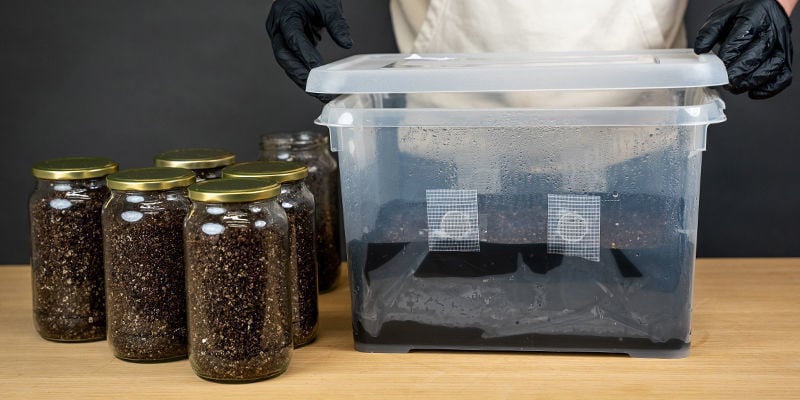
Essentially, a casing layer is a material that's added to the top of the bulk substrate. The casing layer can be made from various materials that are organic, inorganic, or a mixture of both. Its primary function is to retain moisture in the substrate, in turn providing the best possible microclimate for the primordium to form.
What are the benefits of a casing layer?
Why bother to use a casing layer? As mentioned, the prime purpose is to create the best environment for your mushrooms to flourish. This is achieved through several different benefits, such as:
- Prevents the colonised substrate from drying out
- Provides the perfect microclimate for primordia to develop
- Retains moisture and creates a water reservoir for mushrooms to mature
- Supports the growth of beneficial microorganisms
- Helps to prevent contamination (once pasteurised)
While not all mushrooms require a casing layer, there's no denying this technique's benefits.
How to make a casing layer for mushrooms
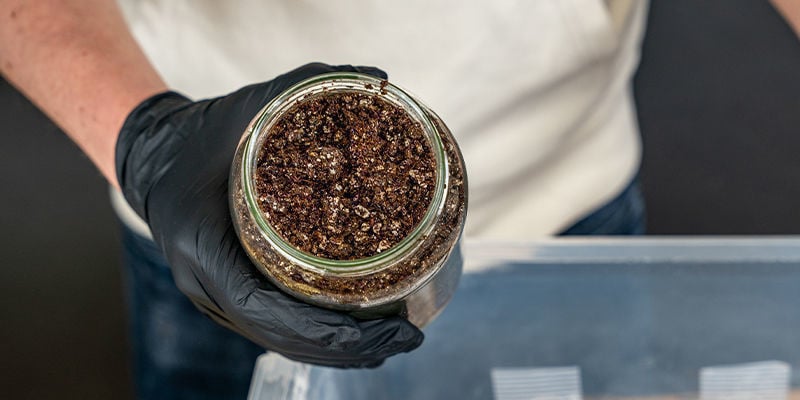
So, how can you go about making a casing layer for yourself? With just a few simple materials and some household equipment, you can follow our step-by-step guide to create a casing layer that will make all the difference for your shrooms.
What can you use for a casing layer?
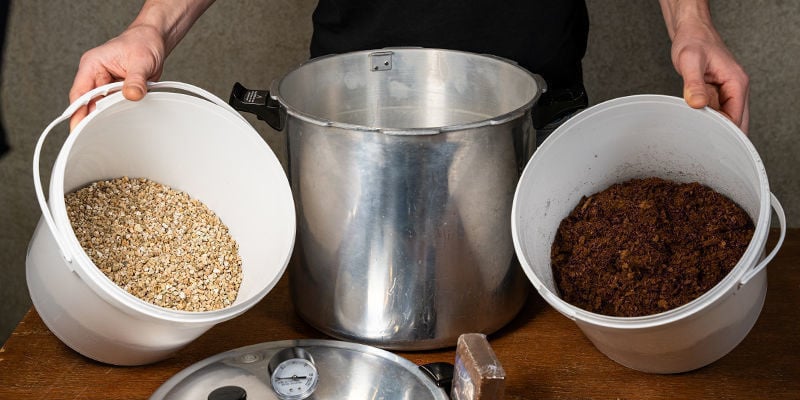
As mentioned, a casing layer can be made from organic and inorganic materials, or a combination of both. Many choose to use peat moss as it can hold up to 10 times its weight in moisture, and if you're a keen gardener already, you might have some ready to use.
Other mushroom-cultivation enthusiasts swear by coco coir. Not only used in hydroponic setups, coco coir retains moisture and also discourages many types of pests from infesting your grow-op.
Lastly, lime and vermiculite are commonly combined with coco coir or peat moss as they can keep pH levels and potential contaminants under control, and also pasteurise it.
These materials are easy to source and can be found at any reputable homeware store or garden centre.
Equipment
For our particular guide, we'll be using a mix of vermiculite and peat moss. Here is the equipment you'll need:
- Large container or mixing bowl
- Spoon
- Pressure cooker or large cooking pot
- Thermometer/temperature probe
- Polypropylene or brew bag
- Vermiculite
- Peat moss
Directions
With all of your equipment ready, it's time to make the casing layer. This isn't an overly complicated guide to follow, but some care, attention, and patience are required to get the best results possible. With that in mind, here's how to do it.
- Empty your peat moss and vermiculite into your mixing bowl or container. You'll want a 50/50 mix, so try to keep the amounts even. Combine the mixture using your hands until suitably mixed.

- Next, add water until the casing layer reaches the proper moisture level. This can be tested by taking a handful of the mixture and squeezing it. The casing layer is too dry if no water comes out when pressed. Conversely, if you give your mix a light squeeze and water streams out, it's too wet. Ultimately, what you want is for only a few droplets of water to come out when you squeeze the mixture as hard as you can.

- Once you've reached the optimal moisture level, spoon your mixture into a bag. While complete sterilisation of your casing layer isn't necessary, pasteurisation is critical to stop any potential contaminants from spoiling your shrooms in the long run. Pasteurisation can be achieved by taking your bagged casing layer and placing it in a pressure cooker or large cooking pot and simmering for around 45–60 minutes.

- During the pasteurisation process, use a thermometer or probe to keep track of the temperature of the casing layer. Maintain a temperature of 65–80°C for about half an hour. This will pasteurise your mixture, making it suitable for use.

- After pasteurisation, the casing layer needs to be cooled before it's ready to use. Allow the bag to reach room temperature, and you have your casing layer. It's worth noting that using a casing layer before it's cooled can have a detrimental effect on your mushrooms and can even straight-up kill your mycelium.

When to add a casing layer
Now that you have your casing layer ready, when is the perfect moment to use it? Use your casing layer just before or just after the mycelium has fully colonised the substrate. Typically, the latter is evident when the mycelium has covered at least 95–100% of the substrate. This will then provide the ideal microclimate for the mushrooms to flourish.
How thick should a casing layer be?
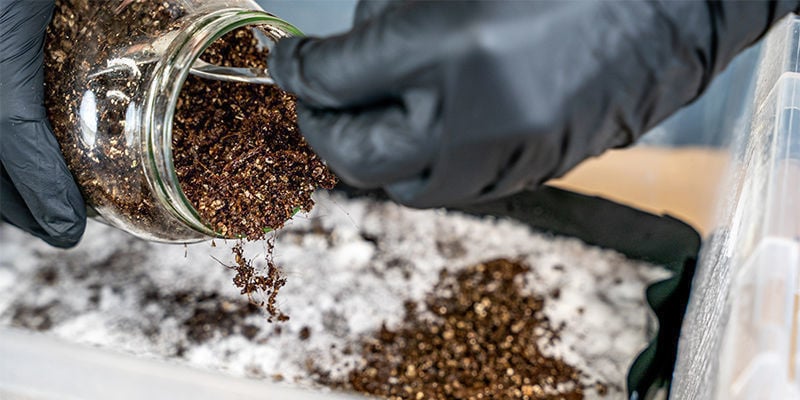
You might be tempted to dump your entire bag over your mycelium-colonised substrate, but there's a little more to it. As a rule of thumb, provide half an inch (~1.27cm) of casing layer for every inch of substrate. However, some look to use around 1–2 inches (2.54–5.08cm) of casing layer, which will also suffice. Of course, it ultimately comes down to the species of mushroom you're growing.
However, while providing a thicker casing layer can offer more insulation and moisture for the mycelium, it can also have a detrimental effect by promoting the growth of mould and bacteria due to the higher levels of moisture.
What to do if your casing layer isn't colonising
If your casing layer isn't colonising the way it should be, it can be as simple as adding too much to your mycelium substrate. This may take some getting used to if this is your first project, but soon, you'll know just how much to use.
However, there can be other factors at play, too. Ensure that the pH of your casing layer is at the correct level. It should have a higher pH level than the substrate to inhibit any mould or bacteria from growing. The ideal pH level is around 6.2–7.2. If the pH is too inconsistent, it will impact colonisation, so be sure to test your casing layer with the proper equipment.
Also, be sure to take the time to pasteurise your casing layer thoroughly, as this can result in contamination and a lack of colonisation.
Is a casing layer necessary?
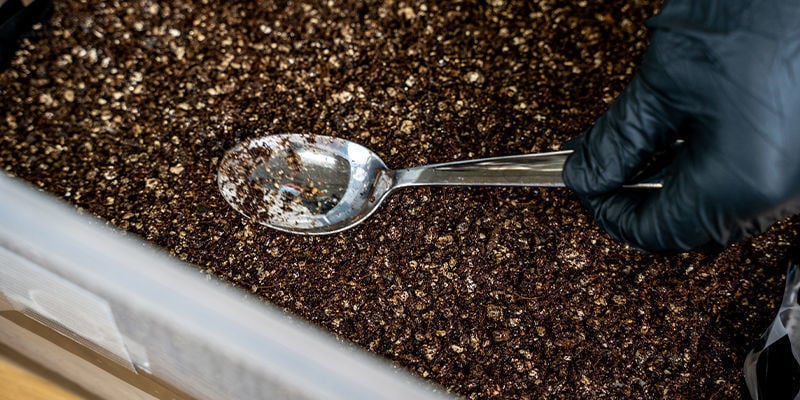
The use of a casing layer is really dependent on the type of mushroom you're looking to cultivate. Arguably, you can grow mushrooms without one, but there's no doubt that it can provide much-needed protection to your mycelium growing project. While it might take a little extra time to prep, there is certainly lots to gain by using a casing layer.
Make the most of your mycelium
Whether you're cultivating delicious mushrooms for cooking or planning a substantial psychedelic trip with psilocybin-packed shrooms, using a casing layer could make all the difference during the growing process.
And if you're looking to cultivate mushrooms from home, Zamnesia has you covered. Head over to the store and get your pick of the finest mushroom equipment and accessories to help you make the most of your mycelium.
-
 4 min
6 June 2023
How To Choose The Right Magic Mushroom Grow Kit
Growing magic mushrooms at home can be extremely difficult. But with our grow kits, it's extremely easy! Now all you need to do is choose one. We're here to help.
4 min
6 June 2023
How To Choose The Right Magic Mushroom Grow Kit
Growing magic mushrooms at home can be extremely difficult. But with our grow kits, it's extremely easy! Now all you need to do is choose one. We're here to help.
-
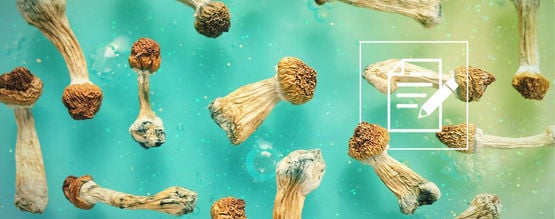 8 min
13 June 2019
What To Know About Shrooms (Magic Mushrooms)
Magic mushrooms are treasured for their strong psychoactive properties, producing strong hallucinations, euphoria, altered thinking processes, and a distinct clarity unlike any other substance....
8 min
13 June 2019
What To Know About Shrooms (Magic Mushrooms)
Magic mushrooms are treasured for their strong psychoactive properties, producing strong hallucinations, euphoria, altered thinking processes, and a distinct clarity unlike any other substance....
-
 3 min
13 June 2019
How To Grow Fresh Mushrooms Kits
3 min
13 June 2019
How To Grow Fresh Mushrooms Kits
-
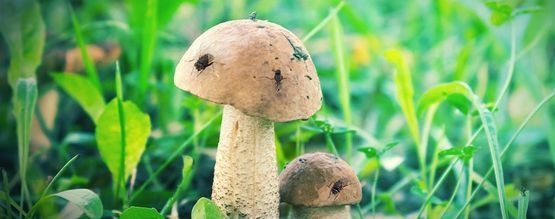 2 min
13 June 2019
How To Protect Your Magic Mushroom Grow From Mushroom Flies
2 min
13 June 2019
How To Protect Your Magic Mushroom Grow From Mushroom Flies













 United States
United States










